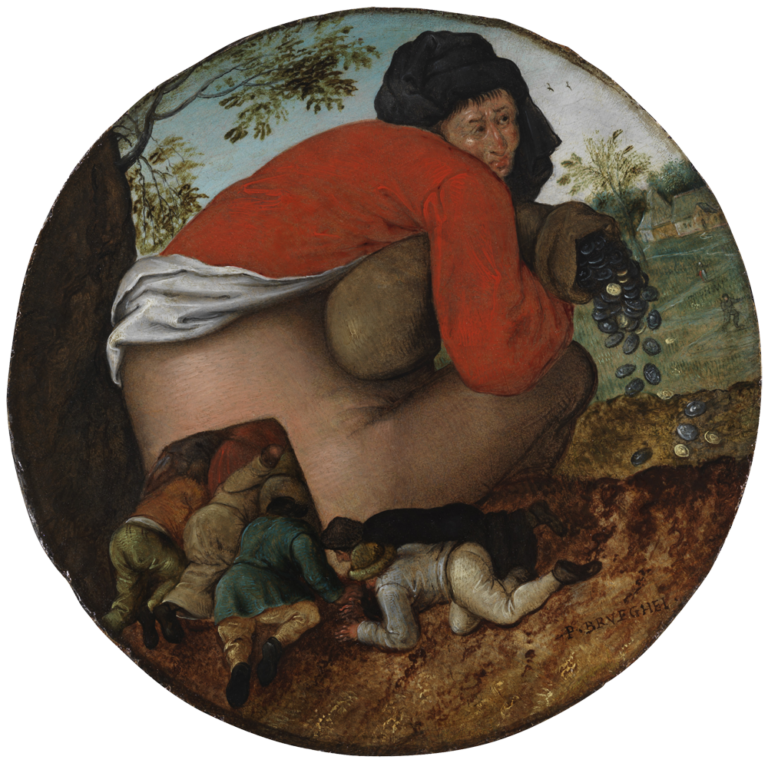This delightfully amusing painting, previously unpublished, depicts an old Flemish proverb that wealthy men will always have flatterers: “Because so much money creeps into my sack, the whole world climbs into my hole.”1 This saying recalls modern day descriptions of flatterers as “brownnosers” or “ass-kissers,” terms that no doubt descend from the vivid pictorial tradition of illustrations such as this. Here, Pieter Brueghel the Younger depicts a disproportionately large man holding a sack of coins that pours out from under his arm. Nude from the waist down, he squats near a tree as though defecating. In the foreground, a number of smaller figures crawl behind him and enter into the cavernous opening of his rear end. With irony and wit, Brueghel indicates that not even the spiritually elevated are spared from this universal tendency to “brownnose,” as a man from a religious order, probably a Franciscan to judge from his brown cloak and hood, eagerly crawls into the man’s hole.
This painting is in excellent condition, with only a few retouchings from prior restorations.2 Quickly executed in loose, wet paint, the translucency of the multiple paint layers allows one to appreciate the artist’s assured handling. The contours and folds of fabrics in highlighted areas of the man’s red shirt and in the dress of the crawling figures are slightly raised because of the paint’s impasto. As is characteristic of Pieter Brueghel the Younger’s manner of painting, the artist sketched the composition directly on the ground and faithfully followed his preparatory drawing in the final composition (fig 1).3
A closely related but unsigned version, which includes an inscription of the proverb on its original frame as well as the painting’s date, 1592, differs in quality as well as in compositional details (fig 2).4 For example, it lacks the branches that extend above the main figure in the Leiden Collection painting, and has a simplified landscape at the right. The rudimentary forms of the crawling foreground figures and the unconvincing three-dimensionality of the central figure suggest that this work was painted in Pieter Brueghel the Younger’s workshop and not by the master.5
Pieter Brueghel the Younger based his composition on a print by Johannes Wierix (1549–ca. 1620), Man with the Moneybag and Flatterers (fig 3), which belongs to a print series, Twelve Proverbs.6 The engraving has two inscriptions, one in Dutch that circles the image and another in French which appears on the squatting man’s lower back. Together, they elaborate on the dual nature of flattery. The Dutch text addresses the great advantage of rich men who use their wealth to get ahead yet lose sight of their own inclination to “crawl into the hole.” The French text speaks of the desire to “enter the hole” of the rich person who is willing to give.7
Despite the close correlation between the Leiden Collection painting and Wierix’s print, Brueghel did make subtle adjustments to his composition. Instead of depicting the man’s left hand distributing coins, he eliminated the hand and depicted the coins as streaming out of the moneybag. He also altered the shape of the bottom of the moneybag, and added a house and tree to the distant landscape.
The designs for Wierix’s engraved series Twelve Proverbs have sometimes been incorrectly attributed to Pieter Brueghel the Younger’s father, Pieter Bruegel the Elder (ca. 1525–69), since the latter’s Twelve Flemish Proverbs in the Museum Mayer van den Bergh in Antwerp are closely related in concept.8 Nevertheless, Wierix’s proverbs belong to a different pictorial tradition.9 As is evident in Pieter Brueghel the Younger’s paintings, Wierix’s print of the flatterer was very popular. It is also seen in a print by Jan Theodor de Bry (1528–96) executed late in the sixteenth century (fig 4).10 Such examples, and the different series of proverbs that survive from the period, underscore the popularity of a genre that humorously mocks human behavior.
